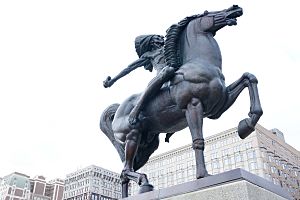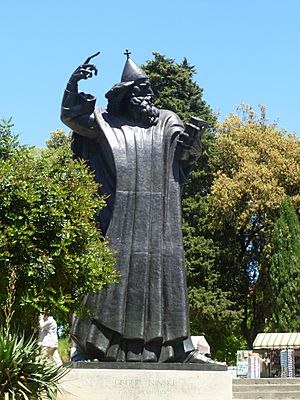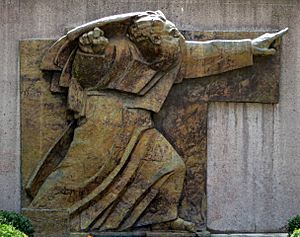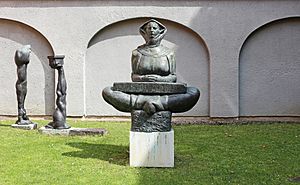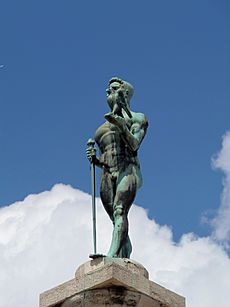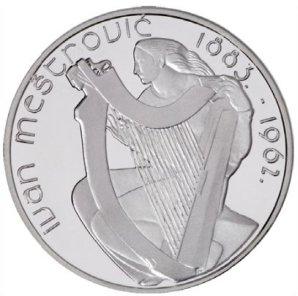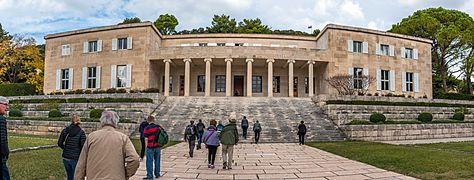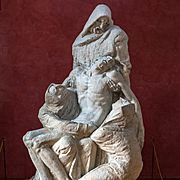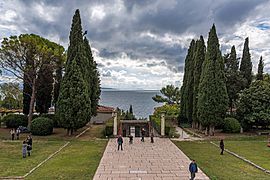Ivan Meštrović facts for kids
Quick facts for kids
Ivan Meštrović
|
|
|---|---|
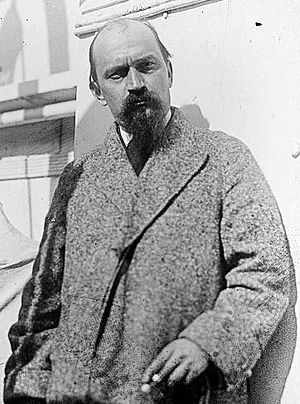
Ivan Meštrović in Zagreb in 1928
|
|
| Born | 15 August 1883 Vrpolje, Kingdom of Croatia-Slavonia, Austria-Hungary
|
| Died | 16 January 1962 (aged 78) South Bend, Indiana, U.S.
|
| Resting place | Otavice, Croatia |
| Nationality | Croatian, Yugoslav and American |
| Alma mater | Academy of Fine Arts Vienna |
| Movement | Art Nouveau, symbolism, Vienna Secession |
| Spouse(s) |
Ruža Klein
(m. 1907; div. 1925)Olga Kesterčanek
(m. 1928) |
| Awards | American Academy of Arts and Letters Gold Medal (1956) |
Ivan Meštrović (born August 15, 1883 – died January 16, 1962) was a famous Croatian sculptor, architect, and writer. He is known as one of the most important modern Croatian sculptors. He was a leading artist in Zagreb during his time.
Meštrović studied art in Split and at the Academy of Fine Arts Vienna in Austria. He was influenced by the Vienna Secession, a group of artists who wanted to create new art styles. He traveled a lot in Europe, studying the works of old masters like Michelangelo and French sculptors such as Auguste Rodin.
His early works often had symbolic meanings and were in the Art Nouveau style. Some of his sculptures, like the Well of Life, show a lively surface, similar to Rodin's style. Other works were inspired by national stories and became large, powerful sculptures, like his Kosovo cycle. Later, his art became more classical. He created many public statues with clear, strong shapes, such as Grgur Ninski in Split and Pobednik in Belgrade. Portraits were also a special part of his work.
Meštrović also designed buildings and monuments. These include the Mausoleum of the Račić family in Cavtat and the Meštrović Pavilion in Zagreb. He also designed a church and his family home, which is now the Ivan Meštrović Gallery in Split.
Contents
Life Story
Early Years
Ivan Meštrović was born in Vrpolje, a village in Slavonia. He spent his childhood in Otavice, a small village in Dalmatia, where his parents were from. His father was a farmer and sheep-herder. When Ivan was sixteen, he became an apprentice to Pavle Bilinić, a master stone carver in Split.
He improved his art skills by studying the grand buildings in Split. Bilinić's wife, who was a teacher, also helped him learn. Soon, a mine owner from Vienna helped Meštrović move there to study at the Academy of Fine Arts Vienna. He had to learn German quickly and get used to a new place, but he did well and finished his studies.
In 1905, he had his first art show with the Vienna Secession group. His work quickly became popular. Even famous sculptor Auguste Rodin praised him, saying Meštrović was an amazing sculptor. Because of his success, Ivan and his first wife, Ruža Klein (whom he married in 1904), were able to travel to more international art shows.
In 1908, Meštrović moved to Paris. The sculptures he made there brought him international fame. In 1911, he moved to Zagreb, and then to Rome. In Rome, he won a top award for the Serbian Pavilion at the 1911 International Exhibition. His work was seen as strong and powerful compared to other artists' pieces. He stayed in Rome for four years, studying ancient Greek sculpture.
Meštrović became a supporter of "Yugoslavism," which was the idea that South Slav people should be united. He created a sculpture of the Serbian folk hero Prince Marko for the 1911 exhibition. When asked about it, Meštrović said it represented the "Yugoslav people with its gigantic and noble heart." People who knew him sometimes called him "The Prophet of Yugoslavism."
During and After World War I
When World War I began, Meštrović tried to return to Split. However, he was advised not to because of his political views against the Austro-Hungarian authorities. During the war, he traveled and held art shows in Paris, Cannes, London, and Switzerland. He also helped create the Yugoslav Committee, a group working for a united South Slav state.
In 1915, he was the first Croatian artist to show his work at the Victoria & Albert Museum in London.
After World War I, he returned to the newly formed Kingdom of Serbs, Croats and Slovenes (later Yugoslavia). He married Olga Kesterčanek, and they had four children: Marta, Tvrtko, Maria, and Mate. They settled in Zagreb in 1922. Meštrović became a professor and later the director of the Academy of Fine Arts in Zagreb. He created many famous works and also donated art to chapels and churches.
By 1923, he designed the mausoleum for the Račić Family Memorial Chapel in Cavtat. He also made statues for a planned national temple in Kosovo, which was meant to honor the 1389 Battle of Kosovo.
Meštrović created many sculptures for the Karađorđević dynasty, especially for King Alexander I of Yugoslavia. These works often promoted the idea of a united Yugoslav nation. Today, many of these sculptures are at the royal compound in Dedinje, Belgrade.
He continued to travel and show his art around the world. He exhibited in New York City in 1924 and Chicago in 1925. He even visited Egypt and Palestine in 1927. In 1927, he designed coins for the Irish Free State. Although his design arrived late, it was later used in 1965 as the seal of the Central Bank of Ireland.
World War II and Later Years
During World War II, in 1941, Meštrović was in Split. He was advised to move to Zagreb for his safety. In November 1941, he was arrested in Zagreb, likely because the authorities feared he would leave the country. He was held in prison for about three and a half months. With help from Archbishop Aloysius Stepinac and the Vatican, he was released. He then traveled to Venice and later to Rome. In July 1943, Meštrović got a visa and moved to Switzerland. Not all of his family were as fortunate; his first wife, Ruža, died in 1942, and many of her Jewish relatives were killed during the Holocaust.
After the war, the new government in Yugoslavia invited Meštrović to return, but he refused. In 1946, Syracuse University in the United States offered him a teaching job, so he moved there. In 1947, he became the first Croatian artist to have his work shown at the Metropolitan Museum of Art in New York City.
In 1953, he received the Gold Medal for sculpture from the American Academy of Arts and Letters. In 1954, President Dwight D. Eisenhower personally gave Meštrović American citizenship. In 1955, he became a professor at the University of Notre Dame.
Before he passed away, Meštrović returned to Yugoslavia one last time to visit with Cardinal Stepinac, who was imprisoned, and with Tito. He sent 59 statues from the United States back to Yugoslavia. In 1952, he gave his Croatian properties, including over 400 sculptures and many drawings, to the people of Croatia.
Two of his children died before him. His daughter Marta died in 1949 at age 24, and his son Tvrtko died in 1961 at age 39.
In 1960, he had a small stroke that affected his eyesight. Ivan Meštrović died in early 1962, at 79 years old, in South Bend, Indiana. His remains were buried in a mausoleum in his childhood home of Otavice.
His son, Mate Meštrović, became a diplomat and professor. His grandson, Stjepan Meštrović, is a sociology professor.
His Art and Fame
Meštrović's sculptures are known for showing the human body with strong feelings and drama. Art critics in Europe and the United States thought very highly of him in the first half of the 20th century. He is one of the most important Croatian artists whose work became famous worldwide.
Professor Miljenko Jurkovic from the University of Zagreb said that Meštrović is "the most renowned modern Croatian sculptor." His works combine different styles and are both grand and poetic. He sculpted in stone, bronze, and wood, creating art about religious themes, portraits, and symbolic ideas.
Historians Wojciech Roszkowski and Jan Kofman noted that Meštrović's sculpture about the 1389 Battle of Kosovo Field won first prize at an international exhibition in 1911. Critics at the time called him one of the greatest sculptors of modern times.
Auguste Rodin often said that Meštrović was "the greatest phenomenon among the sculptors" of his time.
Alonzo Lansford, an editor for Arts Magazine in New York City, wrote in 1947 that Meštrović was "almost unanimously revered by American sculptors of all schools as one of the greatest living sculptors."
Several streets in Serbia are named after him, showing his lasting impact.
Famous Works
Meštrović created over fifty monuments during his two years in Paris (1908–1910). The story of the Battle of Kosovo deeply inspired him, leading to one of his first major works, the Paris Kosovo Monument. Many of his early works honored important moments from Slavic history, as he wanted to promote unity among the Slavic people.
When Yugoslavia was created, Meštrović started focusing on other subjects, like musical instruments or chapels. He especially created religious art, often made of wood, influenced by Byzantine and Gothic architecture styles. His famous early religious works include the Crucifix and Madonna. Later, inspired by Michelangelo Buonarroti, he made many stone reliefs and portraits. His work History of the Croats was even featured on the Croatian dinar currency.
Some of Meštrović's most famous monuments include:
- Canadian Phalanx, a marble relief in Ottawa, Ontario
- Gregory of Nin in Split
- Josip Juraj Strossmayer in Zagreb
- Monument of Gratitude to France in Belgrade
- Monument to the Unknown Hero, Avala, Belgrade
- Victor monument on Kalemegdan Fortress in Belgrade
- Svetozar Miletić in Novi Sad
- Nikola Tesla in Zagreb
- History of Croats in Zagreb and in the Royal Compound, Belgrade (two copies)
- Mausoleum of Njegoš on Mount Lovćen in Montenegro
- The Spring of Life in Zagreb
- The Bowman and The Spearman in Chicago
- St. Jerome the Priest, Washington, D.C.
- Crucifix at St. Joseph Cathedral (Baton Rouge, Louisiana)
Galleries where you can see his work include:
- Ivan Meštrović Gallery in Split: This gallery was created after he made a large donation in 1950. It has 86 statues, 17 drawings, and other works.
- Ivan Meštrović Memorial Gallery in Vrpolje: This gallery in his birthplace has 35 works.
- Snite Museum of Art at the University of Notre Dame: This museum has many of his works because he taught there.
- National Museum of Serbia: This museum holds 45 of his works, including Miloš Obilić and Kraljević Marko.
- Louisiana Arts and Science Museum (LASM) in Baton Rouge: This museum has a large collection of his sculptures and drawings.
Written Works
Meštrović also wrote books. He wrote essays like Moji razgovori s Michelangelom (My Interviews with Michelangelo, 1926). He also wrote his memories about the public and political life of his time in Uspomene na političke ljude i događaje (Memories of Political People and Events, 1969). He even wrote short stories like Ludi Mile (Crazy Mile, 1970).
Some of his notable written works include:
- Stepinac - duhovni heroj (Stepinac - Spiritual Hero), 1956.
- Uspomene na političke ljude i događaje (Memories of Political Persons and Events), 1961.
Gallery
See also
 In Spanish: Ivan Meštrović para niños
In Spanish: Ivan Meštrović para niños



